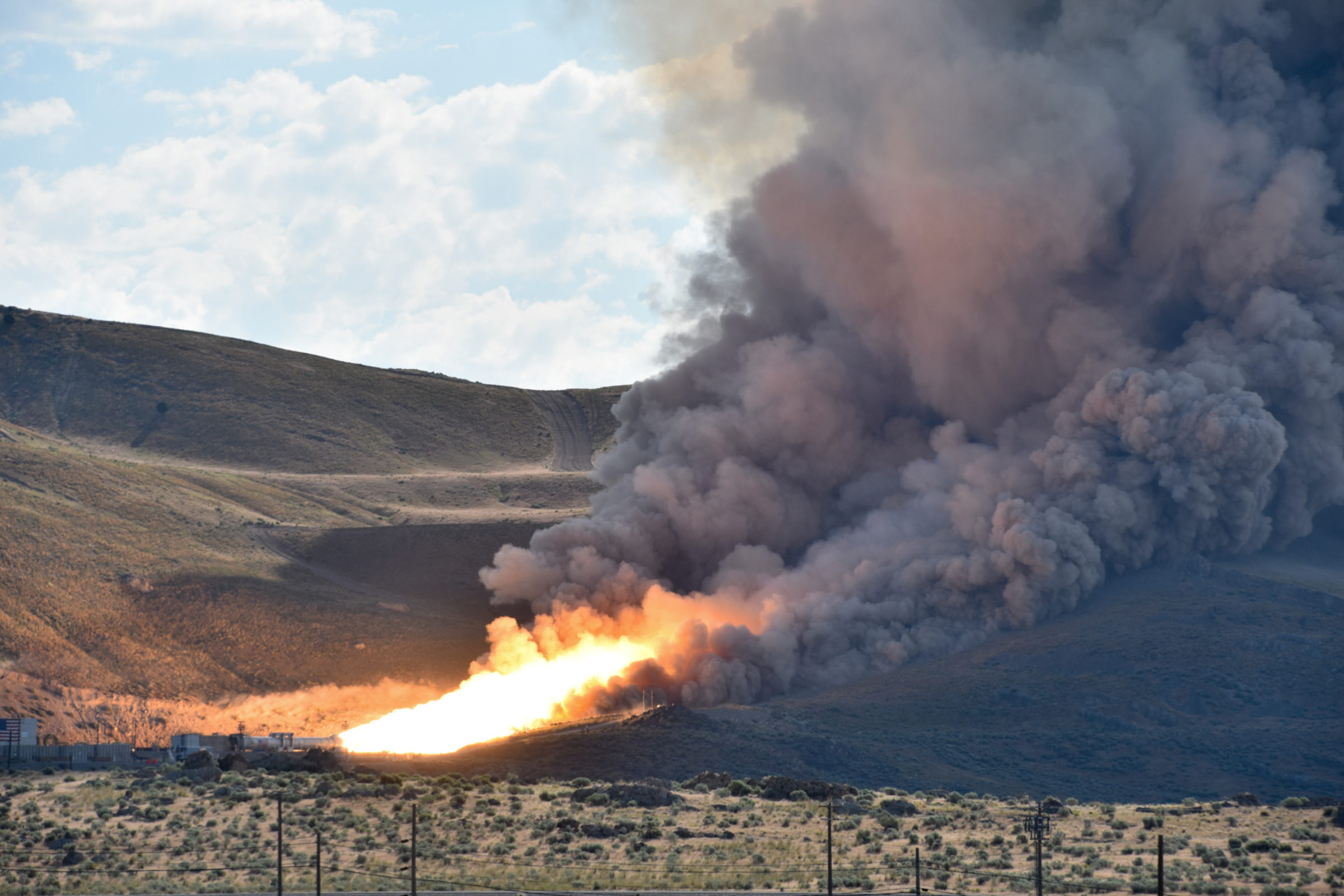Jason Davis • Jun 28, 2016
Big booster blasts Utah hillside, and NASA discusses Journey to Mars
The current heavyweight champion of the solid rocket booster world roared to life here today in Promontory, Utah, completing a two-minute qualification test that paves the way for the booster's use on NASA's new heavy lift rocket, the Space Launch System.
The test was an important milestone for the SLS program and the booster's manufacturer, Orbital ATK, which has already completed the casting process on three of the 10 solid rocket segments that will fly on the Space Launch System in 2018. Shipping of that hardware to Kennedy Space Center in Florida is expected by spring of next year.
"To some folks, 2018 seems like a long way away; to me, it's not that far away," said Bill Gerstenmaier, the associate administrator for NASA'S human exploration and operations division, speaking to reporters after the test. "We should all enjoy this moment, and celebrate just for a little while, and then get back to work."

Flickr photo gallery: QM-2 test
NASA and Orbital ATK tested the world's largest solid rocket booster today in northern Utah. For more pictures, visit our Flickr photo gallery. For more technical details about the test, don't miss our preview article.
The test was originally scheduled to begin at 8:05 a.m. local time (11:05 a.m. EDT, 15:05 UTC). But after a last-minute problem with a ground sequence computer responsible for synchronizing test activities and data collection, the firing was pushed back one hour. Officials said the problem was not related to the booster itself.
"We had to change a hard drive with another version of the software on it to make sure we could proceed with the test," said Charlie Precourt, the vice president and general manager of Orbital ATK's propulsion systems division in Promontory. "The team did a really good job of working their way through that."
A new firing time was set for 9:05 a.m. local time, and on the second try, the test proceeded without a hitch.
As the countdown clock hit zero, a blinding flash of light came from the solid rocket motor's nozzle. There were a few seconds of silence at a viewing site 2 kilometers away, before the sudden snap of a roar that drew cheers from a crowd of NASA and Orbital ATK officials, invited guests, and reporters.
The test was declared a success. "As long as you see flame for 2 minutes and 6 seconds, we've done the vast majority of the work," Precourt said.
After the booster's propellant was exhausted, an automated carbon dioxide extinguisher system swung into the booster to douse any remaining flames. Engineers preserve the booster's interior as much as possible for further data analysis.
Reporters and guests were led to the test site for a closer look. Vegetation on the nearby hillside had been blasted clean, leaving behind the occasional sparkle of glass created by intense heat from the booster exhaust interacting with chunks of sand. A caustic, fireworks-like smell lingered in the air, as workers stood next to the blackened rear nozzle clearing cooling water from around the booster. The plastic wrapper on a few nearby sandbags melted due to the heat.

Today's test was a highly visible milestone for the Space Launch System, which was unveiled five years ago this September. Following the general election in November, NASA and other federal agencies will begin preparing for the first presidential transition in eight years.
The last transition marked one of the most tumultuous periods in the history of NASA's human spaceflight program, as president George W. Bush's return-to-the-moon Constellation program was scrapped by the Obama administration, forcing a Congressional compromise that created the Space Launch System.
NASA's deep space destination subsequently shifted to an asteroid and Mars. But moon-specific language inserted into this year's House spending bill indicates at least the possibility of another human spaceflight skirmish.
"We're here to serve," said Mike Sarafin, the mission manager for Orion's Exploration Mission 1, which launches in 2018. "We don't set policy; we're instruments of that policy." Both Sarafin and Gerstenmaier said NASA designed Orion and SLS as capabilities rather than single-purpose vehicles in order to enable the human exploration of a variety of destinations.
"We really want to go to Mars," said Bill Hill, the deputy associate administrator for NASA's exploration systems development division. "We do have some of our international partners that want to go to the [lunar surface], but we think we can accommodate that through what we call the proving ground activities around the moon."

The shuttle-heritage booster tested today is currently manifested for the first two SLS flights, including a crewed mission to lunar orbit between 2021 and 2023.
The agency's Journey to Mars plans do not currently include a stop on the lunar surface. Hill said it's unclear whether a surface mission would involve technologies directly applicable to the human exploration of Mars, since the moon has no atmosphere and would require different in-situ resource utilization techniques.
"One could make a case that we would expend a lot of money if we went to the moon, especially to the surface, that would delay us getting to the surface of Mars."
Support our core enterprises
Your support powers our mission to explore worlds, find life, and defend Earth. You make all the difference when you make a gift. Give today!
Donate

 Explore Worlds
Explore Worlds Find Life
Find Life Defend Earth
Defend Earth


